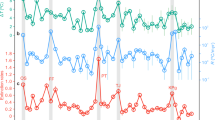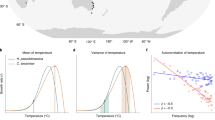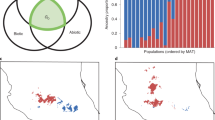Abstract
Arising from: C. D. Thomas et al. Nature 427, 145–148 (2004)); see also communication from Thuiller et al. and communication from Buckley & Roughgarden; Thomas et al. reply Thomas et al.1 have carried out a useful analysis of the extinction risk from climate warming. Their overall conclusion, that a large fraction of extant species could be driven to extinction by expected climate trends over the next 50 years, is compelling: it adds to the many other reasons why new energy policies are needed to reduce the pace of warming.
Similar content being viewed by others
Main
There is one important reason, however, why Thomas et al. could be greatly underestimating the threat to biodiversity from climate change: genetic adaptation to climate at the population level. Thomas et al.1 assume that if the future climate conditions at any particular location within the current range of a species fall outside the climate envelope determined for the entire species, then that location is no longer a suitable habitat for the species. Implicit is the assumption that all individuals within a species are adapted to the same climate envelope — an envelope determined from the current range of the species.
But now consider a species comprising distinct populations that occupy a subset of ranges arrayed along a climate gradient. If each population can survive only within the relatively narrow climate envelope characterizing its current sub-range, then every individual within the species could suffer stress from climate change2. If the individuals cannot migrate, then all individuals within the species would be at risk. By contrast, if existing differential population-level adaptations to climate are ignored, as by Thomas et al., then individuals located towards the cooler end of the current range are unlikely to feel the stress of warming, whether they can migrate or not.
The prevalence of such genetic adaptation to climate at the population level is unknown. Thomas et al. could be overestimating extinction rates if evolutionary adaptation to climate change occurs in the future, lessening the effect of warming on species survival. But the longer generation times of macroscopic species will probably prevent adaptation rates from keeping pace with anthropogenic climate change.
Thomas et al. use a species-level approach for estimating extinction under climate change, in contrast to the more traditional community-level approach that uses the species–area relationship (SAR). Although their methods find inspiration from the power-law form of the community-level SAR, instead of enforcing the SAR at the community level before and after climate change, they aggregate information on species-level range areas into an estimate of extinction for the community. This approach is based on the reasonable assumption that species differ in their response to the effects of climate change. However, their modifications of the classical community-level approach for estimating extinction use a common species-area exponent z for all species, which may not be justified. Species that are sparsely distributed within their climate envelope may be less likely to survive a given fractional change in range than species that are found throughout their climate envelope. Deriving predictions for the community by applying z to all species can yield poor results3.
Species differences in the proportional change to their distributional area also arise under land-use change. If the species-level methods of Thomas et al. were used to estimate extinctions from land-use change, they would yield different estimates from the traditionally used community-level SAR. As noted by Thomas et al., more work is needed to understand how extinction risk for a given species depends on its reduction in range area.
Estimation methods that involve the application of the SAR (or SAR-inspired species-level equations) to regions with holes or fragmentation typically ignore the confounding effects of shape in the dependence of species richness on area4 and, for this reason, may be inaccurate. An alternative estimation method that could be more accurate in some circumstances demonstrates the degree to which shape influences the expected number of extinctions. This relies on the endemics–area relationship (EAR), which quantifies how the number of species spatially confined to a habitat patch depends on the area of that patch3,5,6.
Where the SAR approach asks how many species are present in the remaining habitat, the EAR approach asks how many species are lost because those species were initially present only in the lost habitat. If shape did not influence either, these methods would yield identical results. However, because it does, EAR can yield significantly different answers from the SAR method, depending on the shape and fragmentation of the lost and remaining habitat5,6. Sorting out where the accurate estimate falls between the EAR and SAR estimates requires as-yet unavailable knowledge of how large-scale geographic patterns of diversity depend on shape and fragmentation.
Thomas et al. have focused attention on an important issue. The challenge is to improve our understanding of population genetics and climate tolerance within species, as well as to find the most reliable way to use spatial patterns of diversity and species-level changes in range area for generating estimates of species loss under climate change.
References
Thomas, C. D. et al. Nature 427, 145–148 (2003).
Jensen, D. Thesis, Univ. California, Berkeley (1993).
Green, J. L., Harte, J. & Ostling, A. Ecol. Lett. 6, 919–928 (2003).
Kunin, W. E. Biol. Cons. 82, 369–377 (1997).
Kinzig, A. & Harte, J. Ecology 81, 3305–3311 (2000).
Green, J. L., Harte, J. & Ostling, A. in Biotic Homogenization (eds Lockwood, J. L. &. McKinney, M. L.) 179–200 (Kluwer Academic, New York, 2001).
Author information
Authors and Affiliations
Corresponding author
Rights and permissions
About this article
Cite this article
Harte, J., Ostling, A., Green, J. et al. Climate change and extinction risk. Nature 430, 34 (2004). https://doi.org/10.1038/nature02718
Issue Date:
DOI: https://doi.org/10.1038/nature02718
This article is cited by
-
Evidence and mapping of extinction debts for global forest-dwelling reptiles, amphibians and mammals
Scientific Reports (2017)
-
Species–area relationships always overestimate extinction rates from habitat loss
Nature (2011)
-
Modelling range shifts and assessing genetic diversity distribution of the montane aquatic mayfly Ameletus inopinatus in Europe under climate change scenarios
Conservation Genetics (2011)
-
Increasing impacts of climate change upon ecosystems with increasing global mean temperature rise
Climatic Change (2011)
-
A Strategic Interpretation of Beetle (Coleoptera) Assemblages, Biotopes, Habitats and Distribution, and the Conservation Implications
Journal of Insect Conservation (2006)
Comments
By submitting a comment you agree to abide by our Terms and Community Guidelines. If you find something abusive or that does not comply with our terms or guidelines please flag it as inappropriate.



